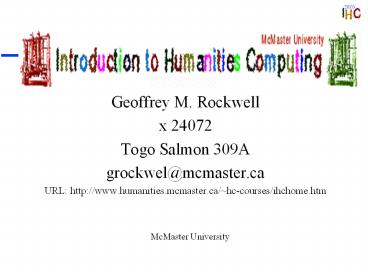Introduction to Humanities Computing - PowerPoint PPT Presentation
Title:
Introduction to Humanities Computing
Description:
Geoffrey M. Rockwell x 24072 Togo Salmon 309A grockwel_at_mcmaster.ca URL: http://www.humanities.mcmaster.ca/~hc-courses/ihchome.htm McMaster University – PowerPoint PPT presentation
Number of Views:156
Avg rating:3.0/5.0
Title: Introduction to Humanities Computing
1
Introduction to Humanities Computing
- Geoffrey M. Rockwell
- x 24072
- Togo Salmon 309A
- grockwel_at_mcmaster.ca
- URL http//www.humanities.mcmaster.ca/hc-courses
/ihchome.htm
McMaster University
2
Evaluate a hypermedia work
- How would you evaluate a hypermedia work?
- What criteria would you use?
3
Possible Criteria
- Usability - Is it easy to use?
- Audience - Is it appropriate for its audience?
- Accuracy - Is the content appropriate and
accurate? - Multimedia Integration - Are the different media
used appropriately and well integrated? - Hypertextuality - Is the hypertext design
appropriate to the content? - Interactivity - Is it interactive? Would it be
better on paper?
4
What is Hypertext?
- Well, by hypertext I mean non-sequential
writing--text that branches and allows choices to
the reader, best read at an interactive screen. - As popularly conceived, this is a series of
text chunks connected by links which of the
reader different pathways. - (Nelson, Literary Machines, p. 0/2)
5
Nodes and Links
Entry Point
Path
6
Anchors and Links
7
Some Proto-Hypertexts
- Encyclopedia - "See also".
- Library - Footnotes.
- Literary Allusions and References.
- Manuscripts and Marginal Glosses.
8
Main Text
Interlinear Text
Secondary Text
Commentary
Marginal Text
9
Manuscript
Main Text
Interlinear Text
Commentary
Marginal Text
Link?
10
Text and Hypertext
11
(No Transcript)
12
1945, Vannevar Bush
- 1945 - As We May Think
- article in the Atlantic Monthly
Keypad
Screens
Storage
Recording Device
Projection
13
1965, Ted Nelson and Xanadu
- THIS BOOK DESCRIBES THE LEGENDARY AND DARING
PROJECT XANADU, AN INITIATIVE TOWARD AN
INSTANTANEOUS ELECTRONIC LITERATURE the most
audacious and specific plan for knowledge,
freedom and a better world yet to come out of
computerdom the original (and perhaps the
ultimate) HYPERTEXT SYSTEM. - (Nelson, Literary Machines, Cover)
14
First Systems
- 1967/8 - Hypertext Editing System and FRESS. Andy
van Dam, Brown University - 1978 - Aspen Movie Map. Andy Lippman, MIT
- 1985 - Intermedia.
- 1987 - HyperCard. Bill Atkinson, Apple
- 1990 - World Wide Web. Tim Berners-Lee, CERN
15
Hypertext (media) Comes of Age
- 1993 - Hyperfiction. On the cover of the New York
Times Book Review - 1993 - Hypermedia Encyclopedias. Print
encyclopedias are surpassed in sales by
hypermedia ones. - 1993 - A Hard Day's Night. Voyager.
- 1995 - Netscape. Netscape Corp is traded on the
stock market.
16
Designing a Hypertext
- When would you decide to use hypermedia for a
work over print technology? - How would you go about designing a hypermedia
work? - How would you make sure your readers are not lost
in your hypermedia work? - What sort of people would you need in a team?
17
Hypertext and Interactivity
- Hypertext is one form of interactivity
- The most common on the Web
- Home Pages, Tables of Content, Navigation Bars,
Indexes, Site Maps, Associative Links, - Image Maps
- What are some other types?
- Searching (Google)
- Visualization (Video, Virtual Spaces)
- Interactive Games and Toys
18
Design of the Whole - Audience
- What is the point of this work?
- Who is your audience?
- Why will they bother?
My Hypertext
How will they interact with it?
19
Hypertext Topography
Home Page
- Branching
- Linear
- Axial
Page 1
Page 3
Page 2
Page 1
Page 2
Page 3
Home Page
Home Page
Annotation
Page 1
Annotation
Page 2
Annotation
Page 3
20
Page Structure
- Where am I?
- What can I do here?
- Where can I go?
Identification
Banner Table of Contents
Page Abstract
Content
Direction of Reading
Internal Associations
Landmark Links
Toolbar
21
Tips
- Have a clear titling scheme so that the reader
knows where they are. - Keep the site fairly flat - dont dice your
content into so many layers of pages that the
reader gets lost. - Be consistent - graphically and hypertextually.
- Have a common toolbar at the bottom of every
page. - Have a credits page.
- Have a signature at the bottom of each page.
22
End































